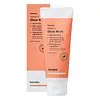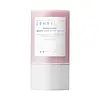What's inside
What's inside
 Key Ingredients
Key Ingredients

 Benefits
Benefits

 Concerns
Concerns

 Ingredients Side-by-side
Ingredients Side-by-side

Water
Skin ConditioningKaolin
AbrasiveGlycerin
HumectantBentonite
AbsorbentPalmitic Acid
Emollient1,2-Hexanediol
Skin ConditioningChlorella Vulgaris Extract
Skin ConditioningZea Mays Starch
AbsorbentSodium Hyaluronate
HumectantCitrus Paradisi Fruit Extract
Skin ConditioningStearic Acid
CleansingCetyl Ethylhexanoate
EmollientGlyceryl Stearate Se
EmulsifyingGlucose
HumectantButylene Glycol
HumectantEthylhexylglycerin
Skin ConditioningCaprylyl Glycol
EmollientFructooligosaccharides
HumectantFructose
HumectantMagnesium Aluminum Silicate
AbsorbentMicrocrystalline Cellulose
AbsorbentMannitol
HumectantSucrose
HumectantMyristic Acid
CleansingArachidic Acid
CleansingTocopheryl Acetate
AntioxidantLauric Acid
CleansingOleic Acid
EmollientTocopherol
AntioxidantAscorbic Acid
AntioxidantCetearyl Alcohol
EmollientXanthan Gum
EmulsifyingDisodium EDTA
CI 77492
Cosmetic ColorantWater, Kaolin, Glycerin, Bentonite, Palmitic Acid, 1,2-Hexanediol, Chlorella Vulgaris Extract, Zea Mays Starch, Sodium Hyaluronate, Citrus Paradisi Fruit Extract, Stearic Acid, Cetyl Ethylhexanoate, Glyceryl Stearate Se, Glucose, Butylene Glycol, Ethylhexylglycerin, Caprylyl Glycol, Fructooligosaccharides, Fructose, Magnesium Aluminum Silicate, Microcrystalline Cellulose, Mannitol, Sucrose, Myristic Acid, Arachidic Acid, Tocopheryl Acetate, Lauric Acid, Oleic Acid, Tocopherol, Ascorbic Acid, Cetearyl Alcohol, Xanthan Gum, Disodium EDTA, CI 77492
Water
Skin ConditioningKaolin 8%
AbrasiveDipropylene Glycol
HumectantGlycerin
HumectantCI 77891
Cosmetic ColorantButylene Glycol
HumectantSodium Stearate
CleansingCentella Asiatica Extract 4.9%
Cleansing1,2-Hexanediol
Skin ConditioningPhaseolus Angularis Seed Powder
Aloe Barbadensis Leaf Extract
EmollientCetearyl Olivate
Propanediol
SolventSorbitan Olivate
EmulsifyingDimethicone
EmollientCI 77491
Cosmetic ColorantEthylhexylglycerin
Skin ConditioningSodium Phytate
Bentonite
AbsorbentIllite
AbrasiveMineral Salts
Skin ConditioningMontmorillonite
AbsorbentCalamine
AbsorbentWater, Kaolin 8%, Dipropylene Glycol, Glycerin, CI 77891, Butylene Glycol, Sodium Stearate, Centella Asiatica Extract 4.9%, 1,2-Hexanediol, Phaseolus Angularis Seed Powder, Aloe Barbadensis Leaf Extract, Cetearyl Olivate, Propanediol, Sorbitan Olivate, Dimethicone, CI 77491, Ethylhexylglycerin, Sodium Phytate, Bentonite, Illite, Mineral Salts, Montmorillonite, Calamine
 Reviews
Reviews

Ingredients Explained
These ingredients are found in both products.
Ingredients higher up in an ingredient list are typically present in a larger amount.
1,2-Hexanediol is a synthetic liquid and another multi-functional powerhouse.
It is a:
- Humectant, drawing moisture into the skin
- Emollient, helping to soften skin
- Solvent, dispersing and stabilizing formulas
- Preservative booster, enhancing the antimicrobial activity of other preservatives
Bentonite is an aluminium phyllosilicate clay with great absorbent properties. The name 'bentonite' comes from the area where the largest source is found: Fort Benton, Wyoming.
As a clay, bentonite is often used to absorb excess oil and provide exfoliation. It has also been shown to have some antibacterial and anti-inflammatory properties. Studies show bentonite was effective at calming dermatitis from poison ivy and in diaper dermatitis of infants. Bentonite has also been shown to act as a barrier against toxic compounds on your skin.
Sunscreens containing bentonite display higher water resistance and stay on the skin for much longer. The sunscreens containing bentonite also show higher potency and UV light absorbtion.
Bentonite is naturally created from volcanic ash and several natural weathering/hydrothermal processes.
A common usage of bentonite is removing excess protein from white wines. Bentonite contains a property of being able to absorb large amounts of protein from aqueous solutions.
Phyllosilicate clay has a structure formed by sheets.
Learn more about BentoniteButylene Glycol (or BG) is used within cosmetic products for a few different reasons:
Overall, Butylene Glycol is a safe and well-rounded ingredient that works well with other ingredients.
Though this ingredient works well with most skin types, some people with sensitive skin may experience a reaction such as allergic rashes, closed comedones, or itchiness.
Learn more about Butylene GlycolEthylhexylglycerin (we can't pronounce this either) is commonly used as a preservative and skin softener. It is derived from glyceryl.
You might see Ethylhexylglycerin often paired with other preservatives such as phenoxyethanol. Ethylhexylglycerin has been found to increase the effectiveness of these other preservatives.
Glycerin is already naturally found in your skin. It helps moisturize and protect your skin.
A study from 2016 found glycerin to be more effective as a humectant than AHAs and hyaluronic acid.
As a humectant, it helps the skin stay hydrated by pulling moisture to your skin. The low molecular weight of glycerin allows it to pull moisture into the deeper layers of your skin.
Hydrated skin improves your skin barrier; Your skin barrier helps protect against irritants and bacteria.
Glycerin has also been found to have antimicrobial and antiviral properties. Due to these properties, glycerin is often used in wound and burn treatments.
In cosmetics, glycerin is usually derived from plants such as soybean or palm. However, it can also be sourced from animals, such as tallow or animal fat.
This ingredient is organic, colorless, odorless, and non-toxic.
Glycerin is the name for this ingredient in American English. British English uses Glycerol/Glycerine.
Learn more about GlycerinKaolin is a clay. It is used for oil control and to help minimize pores. Like other clays, kaolin has the ability to absorb excess sebum or oil. This can help clean out pores and mattify the skin.
Some types of kaolin may have exfoliating properties. When water is added to kaolin, it becomes a paste with small abrasive particles.
Most kaolin is a white color, but may be pink/orange/red depending on where it comes from.
The name 'kaolin' comes from a Chinese village named 'Gaoling'. Kaolin clay comes from rocks rich in kaolinite. Kaolinite, the mineral, has a silicate layered structure. Kaolinite is formed from chemical weathering of aluminum siilicate minerals.
Besides skincare, kaolin is commonly used to make glossy paper, in ceramics, toothpaste, and as medicine to soothe stomach issues.
Learn more about KaolinWater. It's the most common cosmetic ingredient of all. You'll usually see it at the top of ingredient lists, meaning that it makes up the largest part of the product.
So why is it so popular? Water most often acts as a solvent - this means that it helps dissolve other ingredients into the formulation.
You'll also recognize water as that liquid we all need to stay alive. If you see this, drink a glass of water. Stay hydrated!
Learn more about Water